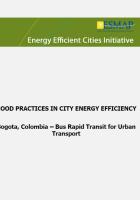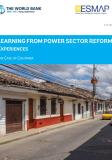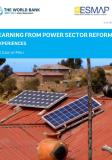Publications
Bogota, Colombia's capital, is located near the geographic center of the country, 2,640 meters (8,661 ft) above sea level. It is the largest and most populous city in the nation, with an estimated population of 8.2 million in the metropolitan area in 2007 and a population density of 3,912 inhabitants per square kilometer. Its economy generates 25% of Colombia's total gross domestic product (GDP).
Over the past two decades, the city's roads had become highly congested following significant growth in private car ownership and use. While private cars occupied 64% of road space, their occupants represented just 19% of the population, with a daily average commute of 70 minutes each way. Other issues included a high rate of accidents and extremely severe air pollution during peak travel hours.
By the end of the 1990s, Bogota's public bus transportation system suffered from underuse, with poor quality service and efficiency. The average speed of public transportation was 10 km/hour, reduced to 5 km/hour during peak hours due to heavy traffic. Passengers became increasingly frustrated by long wait times for buses. To reduce waiting time, riders had to use the first bus available rather than wait for a less expensive bus to arrive. Without price regulation, private bus operators were free to hike up prices and charge far more than public bus operators.
In 1998, Mayor Peñalosa launched a long-term urban mobility plan, as part of an urban renewal strategy. It consisted of measures that would restrict private automobiles, promote non-motorized transportation, and improve public transit by partly financing infrastructure improvements. In 1999, after the new National Government rejected plans for a subway system, Bogota's Mayor presented his plan for a Bus Rapid Transit (BRT) system, built on a successful experience in Curitiba, Brazil. Transitioning to a BRT system would help realize the Mayor's four main goals by (i) improving the public transport system with respect to efficiency, safety, speed, convenience, and comfort, ensuring high ridership; (ii) restricting private automobile use; (iii) expanding and improving bicycle paths; and (iv) increasing availability of public space.
ESMAP. 2009. Good Practices in City Energy Efficiency: Bogota, Colombia - Bus Rapid Transit for Urban Transport. ESMAP Energy Efficient Cities Initiative. Washington, DC: World Bank.



